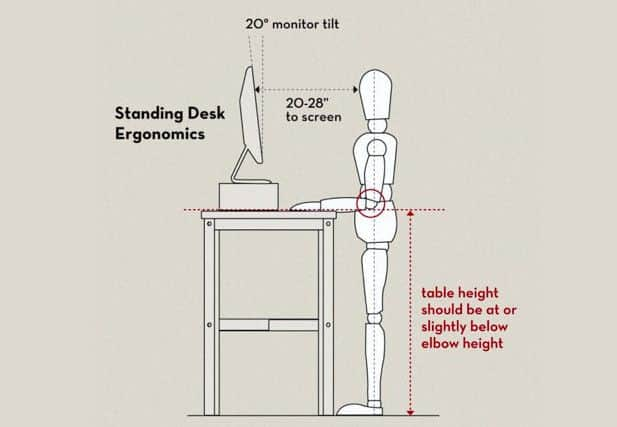Why standing desks could save Scots workers’ lives


Work can be hard sometimes - but did you know that your time in the office could be killing you?
Major research has proven that sitting too much can be fatal – one in six deaths in the UK have been linked to a sedentary lifestyle. It has also been linked to cancers, heart disease, and diabetes, as well as chronic back and neck pain.
Advertisement
Hide AdAdvertisement
Hide AdEven if you’re the type to offset a stressful day at your workstation with a good workout at the gym, it might not matter. Researchers have found that even physical activity may not be enough to offset the harm caused. And with office workers spending 85 per cent of their day sitting down, you can see where the risk lies for those who spend their days deskbound.


A movement is gathering pace to “Get Britain Standing”, with pockets of good workplace practice emerging across Scotland. NHS Highland, for example, is encouraging its employees to hold meetings standing up and walk to find their colleagues, instead of sending an email or phoning across the office.
The UK lags dangerously behind other nations when it comes to improving the health and wellbeing of its employees. In Denmark, it is now law to offer workers a sit-stand desk where your monitor and keyboard can be easily raised, so you can mix up your working position.
Eighty per cent of workers there now have access to the kit, but it is thought that only one per cent of workers in this country have the same privilege.
Standing up at work is nothing particularly new – Winston Churchill was known to have used a special standing desk, as did Ernest Hemingway and Benjamin Franklin. In the 19th century, Victorian clerks also did their business standing up and moved around as a matter of course.
Stuart Palma, a professional advisor for the Chartered Society of Physiotherapy, said standing desks have to be considered by employees once again, given the “horrendous” figures linking sitting down to poor health.
Mr Palma said: “The figures speak for themselves, they are horrendous. We spend 85 per cent of our time in the office sitting down and an average of 12-hours a day sitting down. A sit-stand desk offers a release to that and they have been demonstrated to boost productivity by about 10 per cent.
“When you standup your heart beat speeds up by 10 beats a minute so you are burning more calories over the hour. Standing up causes the postural muscles to kick in, your joints are lubricating themselves, you are more dynamic, and you are testing your balance.
Advertisement
Hide AdAdvertisement
Hide Ad“When you relate that back to 31 million work days lost at work to muscle-skeletal disorders, such as back and neck pain, and that back pain alone costs business £7bn a year, you can see the wider social impact of being inactive at work. It’s catastrophic.”
Sedentary lifestyles have long been linked to cardiovascular disease and diabetes and a major review of 70,000 cases of cancers at the University of Hamburg found that sitting was associated with a 24 per cent increased risk of colon cancer, a 32 per cent increased risk of endometrial cancer, and a 21 per cent increased risk of lung cancer.
If that isn’t enough to worry about, it was also established that you can’t exercise away the damage.
The research paper said: “Adjustment for physical activity did not affect the positive association between sedentary behaviour and cancer. Even participants who achieved the daily recommended levels of physical activity were at the same risk as those who spent their day sitting.
“[The results] indicate that the increased risk of cancer seen in individuals with prolonged time spent sedentary is not explained by the mere absence of physical activity in those persons”
Mr Palma said employers could easily see returns on investing in sit-stand desks, with companies breaking even on one desk in 10 years if an employee took just one less sick day a year. Separate research has found that workers using sit-stand desks feel 87 per cent more energised, 71 more focussed and 33 per cent less stressed. A 42 per cent in productivity was also recorded.
But with companies seeing workplace design as more of a cost than an investment, securing cultural change could take time, Mr Palma said. However, he added that new technology was making it far easier to adapt existing furniture to give workers the choice of standing, Adaptations can cost around £200, but new desks can be several hundred pounds more.
“It is about a change in culture but I would ask if we can afford not to make these changes when the figures are as stark as they are,” Mr Palma said.
Advertisement
Hide AdAdvertisement
Hide AdOne firm that has long been ahead of the game is Aveloq, the banking IT company, which first introduced sit-stand desks when it opened in Edinburgh in 2012.
Chris Zwicker, managing director of its research and development centre in the capital, said they bought the kit after some employees in Switzerland chose to use it.
Mr Zwicker said: “We had standing desks for a few employees there who had back pain and then alot of people started to want them. We thought why not just do it for everyone?
“If they are moving around their desks it seems to increase motivation. It makes people less stressful and people seem to work a little longer, or for the time they are in the office, they seem to work more.”
Mr Zwicker said the desks had been a good investment for his staff.
He added that some employees chose to conduct meetings on sitting balls - which help strengthen core muscles and improve posture - and that a range of different chairs helped to “contribute to a good working environment.”
Mr Zwicker sai: One thing we did invest in was making sure people were comfortable at work.
He added it was hard to say if this environment had led to lower sickness rates as the equipment had been in place since the office opened.
Advertisement
Hide AdAdvertisement
Hide Ad“We do have very low absence rates - we barely have anyone off sick from work,” he said.
Colin Borland, of the Federation of Small Businesses in Scotland, said offering sit-stand desks should be considered by employers.
He said: “It is a realistic option if the health benefits are as dramatic as some of the experts seem to believe. I think yes, companies could offer them as an option. I wouldn’t suggest you have to rip out everything and start again, but when it comes to replacing furniture, they could be considered.”
In the meantime, Get Britain Standing encourages workers to take phone calls on their feet – something which boosts confidence and voice quality – and removing tables and chairs from meeting rooms, which can also lead to shorter meetings. They also suggest not taking lunch at your desk.
In the United States, some employees are using wobble boards at their sit-stand desks to increase movement even further. Pictures have also emerged of treadmill desks, where employees can pound away while keeping an eye on their work.
A walk to the canteen, however, may just be a good place to start.